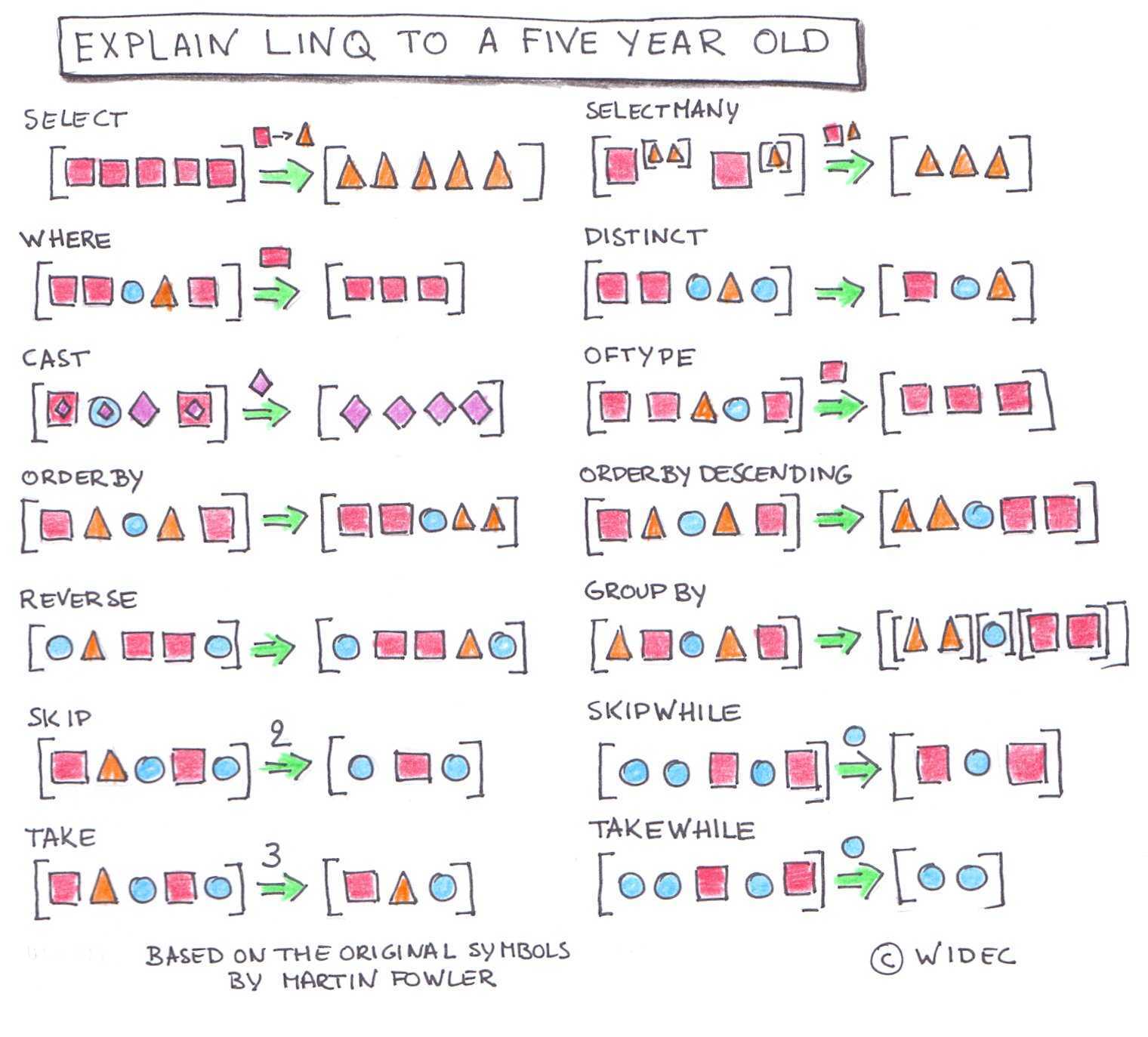Comparison Table
| C# |
JavaScript |
MDN Link |
| Select() |
map((cur, index, array): any) |
map |
| Where() |
filter((cur): boolean) |
filter |
| Contains() |
includes(value, fromIndex) |
includes |
| FirstOrDefault() |
find((cur): boolean): undefined | any |
find / findIndex |
| LastOrDefault() |
findLast((cur): boolean): undefined | any |
findLast / findLastIndex |
| All() |
every((cur): boolean): boolean |
every |
| Any() |
some((cur): boolean): boolean |
some |
| Concat() |
concat(arr: any[]): any[] |
concat |
| Skip(start).Take(start – end) |
slice(start = 0, end = length-1) |
slice |
| string.Join() |
join(separator = ‘,’) |
join |
| Array.IndexOf() |
findIndex((cur): boolean): -1 | number |
findIndex |
| ElementAt() |
at(index) (accepts negative indexes) |
at |
| Count() |
length: number |
length |
| SelectMany() |
flat(levels = 1) / flatMap(fn) |
flat / flatMap |
| GroupBy() |
Object.groupBy(arr, groupFn) |
groupBy |
| Distinct() |
filter((el, i, arr) => arr.indexOf(el) === i) |
|
| Extension method |
forEach((cur): void): void |
forEach |
|
|
|
| Mutating in JS |
These are in place operations |
|
| OrderBy() |
sort((a, b): number) |
sort / toSorted |
| Reverse() |
reverse() |
reverse / toReversed |
Commonly used methods
Select = map
// C#
var result = enumerable.Select(x => x);
// JavaScript
let result = array.map(x => x);
// Using spread to avoid mutation
const input = [{k: 1, v: true}, {k: 2, v: false}];
const result = input.map(x => ({...x, v: !x.v}))
When mapping to an object without code block, you need to wrap your object between extra parentheses like
[0, 1].map(x => ({value: x}));
// Because without the extra parentheses
[0, 1].map(x => {value: x});
// --> [undefined, undefined]
// it is the same as writing:
[0, 1].map(x => {
value: x; // No error, because JavaScript?
return undefined;
});
Where, Distinct = filter
Where and filter behave pretty much exactly alike. Linqs Distinct we’ll need to implement ourselves.
const input = [0, 0, 1, 5, 5];
// Equals true when the first occurrence of the value is the current value
const result = input.filter((element, index, array) => array.indexOf(element) === index);
// Or: [...new Set(input)];
expect(result).toEqual([0, 1, 5]);
Aggregate, GroupBy, … = reduce
Linq has Sum, Min, Max, Average, GroupBy, etc. While JavaScript doesn’t have them, they can all be achieved trivially with reduce
Sum, Min, Max, Average:
const input = [0, 1];
const sum = input.reduce((total, cur) => total + cur, 0);
const average = sum / input.length;
const min = Math.min.apply(Math, input); // Old school
const min = Math.min(...input); // Using spread
Aggregate, GroupBy:
const input = [0, 1, 2, 3];
const result = input.reduce((acc, cur) => {
if (cur % 2 === 0) {
acc.even.push(cur);
} else {
acc.odd.push(cur);
}
return acc;
}, {even: [], odd: []});
expect(result).toEqual({even: [0, 2], odd: [1, 3]});
Since 2024, JS has a dedicated Object.groupBy:
const socks = [
{ name: 'JavaScript', type: 'lang' },
{ name: 'Angular', type: 'package' },
{ name: 'React', type: 'package' },
];
const grouped = Object.groupBy(socks, sock => sock.type);
expect(grouped).toEqual({
lang: [{ name: 'JavaScript', type: 'lang' }],
package: [
{ name: 'Angular', type: 'package' },
{ name: 'React', type: 'package' },
]
})
slice
Linq has First, Last, Skip, SkipLast, SkipWhile, Take, TakeLast, TakeWhile. JavaScript has slice.
// Shallow copy
const input = [0, 1, 2, 3];
expect(input.slice()).toEqual([...input]);
// Signature
slice(startIndex = 0, endIndex = length-1);
C# Ranges
var array = new[] { 1, 2, 3, 4, 5 };
Assert.Equal(new[] { 3, 4 }, array[2..^1]);
Assert.Equal(new[] { 1, 2 }, array[..^3]);
Assert.Equal(new[] { 3, 4, 5 }, array[2..]);
Assert.Equal(new[] { 1, 2, 3, 4, 5 }, array[..]);
with
Since 2023, there is also with which returns a new array where one item is replaced with a new value by index.
const newArr = arr.with(index, newValue);
Mutations
These functions operate in place.
Since ECMAScript 2023, some have non-mutating alternatives!
OrderBy = sort and toSorted
- Use toSorted if you need a new array for the sorted result.
- Without compareFn the array is sorted according to each character’s Unicode code point value.
- The compareFn should return a number:
-1 (or any negative number): a comes beforeb0: Equal1 (or any positive number): a comes afterb
// Numbers
[10, 5].sort(); // [10, 5]: each element is converted to a string
[10, 5].sort((a, b) => a - b); // [5, 10]
// Strings
['z', 'e', 'é'].sort(); // ['e', 'z', 'é']
['z', 'e', 'é'].sort((a, b) => a.localeCompare(b)); // ['e', 'é', 'z']
// Dates
[d1, d2, d3].sort((a, b) => a.getTime() - b.getTime());
C#
- The signature is a bit different:
OrderBy(Func<TSource, TKey> keySelector, IComparer<TKey> comparer)
OrderBy vs OrderByDescending: switch a and b…- JS doesn’t have
ThenBy chaining possibilities, you’ll have to do this yourself.
forEach
While forEach is not really doing any mutation by itself, it is often what it’s used for. Mutations are especially dangerous in for example a Redux environment where UI changes might lag. The same can usually be achieved with map.
const input = [{value: 1, visited: 0}, {value: 2, visited: 0}];
// Potentially dangerous
input.forEach(el => {
el.visited++;
});
// ...el will create a shallow copy only!
const result = input.map(el => ({...el, visited: el.visited + 1}));
// Or use the good old loop?
for (let itm of input) {
console.log(itm.value);
}
Other mutators
Linq for ages 5 and up
Thanks Wim De Cleen (and Martin Fowler) for this amazing diagram, I love it!




